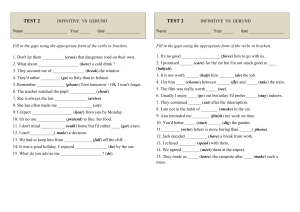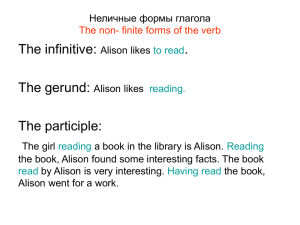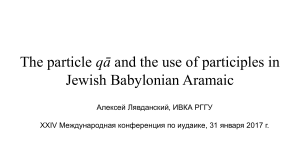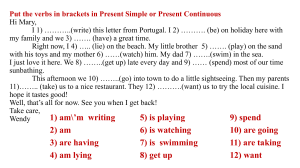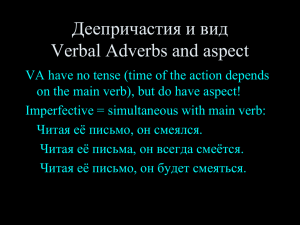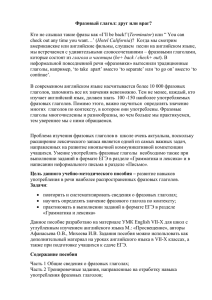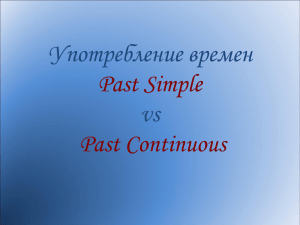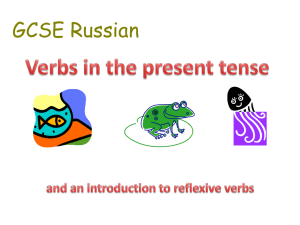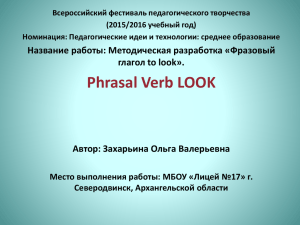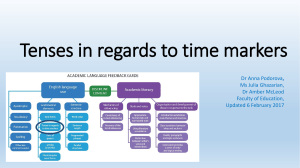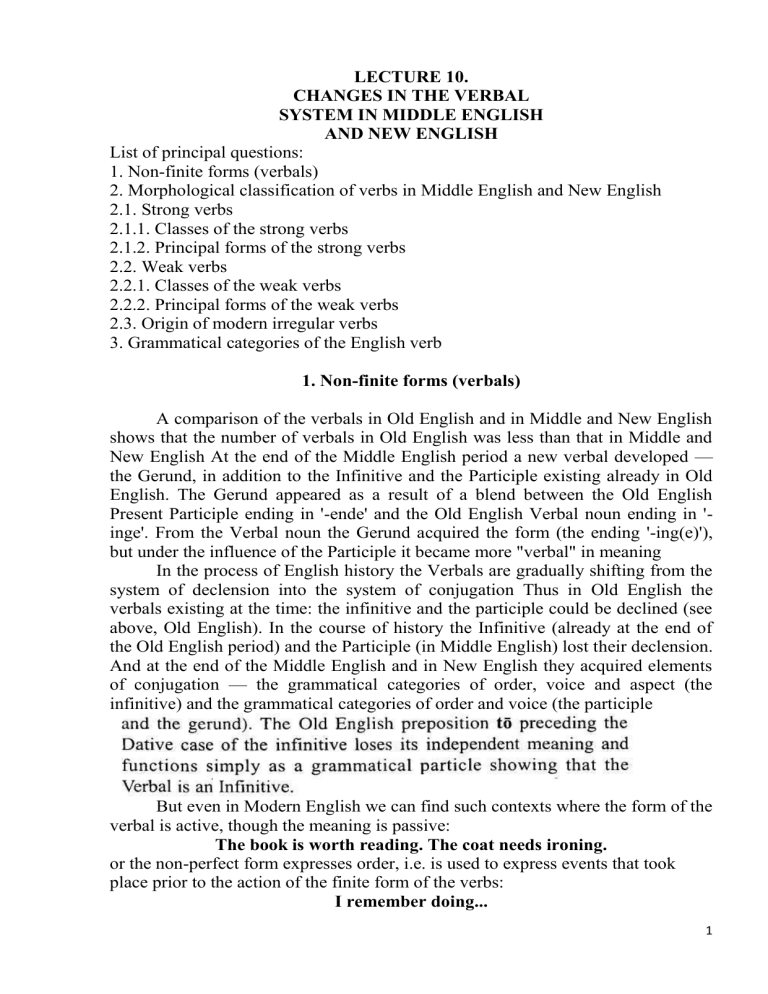
LECTURE 10. CHANGES IN THE VERBAL SYSTEM IN MIDDLE ENGLISH AND NEW ENGLISH List of principal questions: 1. Non-finite forms (verbals) 2. Morphological classification of verbs in Middle English and New English 2.1. Strong verbs 2.1.1. Classes of the strong verbs 2.1.2. Principal forms of the strong verbs 2.2. Weak verbs 2.2.1. Classes of the weak verbs 2.2.2. Principal forms of the weak verbs 2.3. Origin of modern irregular verbs 3. Grammatical categories of the English verb 1. Non-finite forms (verbals) A comparison of the verbals in Old English and in Middle and New English shows that the number of verbals in Old English was less than that in Middle and New English At the end of the Middle English period a new verbal developed — the Gerund, in addition to the Infinitive and the Participle existing already in Old English. The Gerund appeared as a result of a blend between the Old English Present Participle ending in '-ende' and the Old English Verbal noun ending in 'inge'. From the Verbal noun the Gerund acquired the form (the ending '-ing(e)'), but under the influence of the Participle it became more "verbal" in meaning In the process of English history the Verbals are gradually shifting from the system of declension into the system of conjugation Thus in Old English the verbals existing at the time: the infinitive and the participle could be declined (see above, Old English). In the course of history the Infinitive (already at the end of the Old English period) and the Participle (in Middle English) lost their declension. And at the end of the Middle English and in New English they acquired elements of conjugation — the grammatical categories of order, voice and aspect (the infinitive) and the grammatical categories of order and voice (the participle But even in Modern English we can find such contexts where the form of the verbal is active, though the meaning is passive: The book is worth reading. The coat needs ironing. or the non-perfect form expresses order, i.e. is used to express events that took place prior to the action of the finite form of the verbs: I remember doing... 1 I thanked him for bringing the happy tidings. Such phenomena reflect the previous stage of the development of the English language, when the given verbals were indifferent to voice and order. 2. Morphological classification of verbs in Middle English and New English 2.0. The subdivision of Old English verbs into Strong and Weak is preserved with modifications in Middle English. 2.1. Strong verbs 2.1.1. Classes of the strong verbs In New English, however, the original regularity that was observed in the group of strong verbs in Old English and partly in Middle English is no longer felt due to the following: 1) Splitting of original classes into subclasses, for example: 2) Some strong verbs of one class entering another class. Thus, the Old English verb of the 5th class: on analogy with such verbs as stelen — stal — stelen — stolen. 3) Passing of some strong verbs into the group of weak verbs and (rarely) vice versa. For example: Old English New English I class gripan to grip glidan to glide II class creopan to creep leo3an to lie III class climban to climb helpan to help VI class bacan to bake wascnan to wake The contrary process, as we have already said, is quite rare: Old English New English hydan to hide waerian to wear 4) But some weak verbs acquired only some features of the strong verbs, like the Old English weak verb sceawian — Modern English show, showed, but shown. 2 2.1.2. Principal forms of the strong verbs The strong Verbs in Old English had four principal forms, for example: In Middle English, however, they exhibited a marked tendency to have the same vowel in both the forms of the past tense, thus gradually reducing the number of the principal forms to three. In New English we have only three principal forms in verbs originally belonging to the group of strong verbs: write — wrote — writen The vowel that is preserved in the Past tense is generally traced back to the vowel of Old English past tense singular. For example: with the Past tense form deriving its vowel from the past tense plural form of the verb. Sometimes the vowel of the past tense form was borrowed from the form of the past participle: 2.2. Weak verbs As we have said above the number of strong verbs was diminishing in Middle English and New English mainly due to the passing of some strong verbs into the weak conjugation. Weak verbs, however, were becoming more and more numerous, as they not only preserved in Middle and New English almost all the verbs that were typical of the group in Old English, but also added to their group the majority of borrowed verbs and about seventy verbs originally strong (see above), and also such verbs as: to call to want Scandinavian borrowings to guess to pierce to punish to finish French borrowings to contribute 3 to create Latin borrowings to distribute Alike strong verbs many weak verbs became irregular in the course of history, especially weak verbs of the first class This irregularity was mainly conditioned by qualitative and quantitative changes that many weak verbs underwent in Middle English and New English. For instance: As we see the Old English weak verb of the first class became irregular due to the quantitative change — shortening of the vowel in the second and third forms in Middle English (before two consonants — for example, pt), thus acquiring quantitative vowel interchange. This quantitative interchange was followed by qualitative in New English after the Great vowel shift, which only the vowel of the first form, being long, underwent, the short vowel of the second and third forms retaining their quality. 2.2.1. Classes of the weak verbs In Old English there were two principal classes of the weak verbs. In Middle English some verbs that did not become irregular lost the class difference and .we have but one class of verbs going back mainly to the weak verbs of the second class. For instance: Old English II class lufian — lufode — lufod (to love) Middle English loven — lov(e)de — luv(e)d 2.2.2. Principal forms of the weak verbs In Old English there were three principal forms of the weak verbs, for instance: In Late Middle English — Early New English, with the loss of the final -e in the second form the second and the third form became homonymous, thus we speak of three principal forms of such verbs as to love or to keep mainly on analogy with original strong verbs, and also because of the existing tradition as no Modern English regular verb, originally belonging to the weak conjugation, shows any trace of difference between the second and third forms. Thus in New English due to different phonetic processes and changes on analogy the two principal groups of verbs that existed in Old English, strong and weak, gave us two principal groups of Modern verbs: regular and irregular, neither of which is directly derived from either of the Old English groups of strong and weak verbs. 2.3. Origin of modern irregular verbs In Old English most verbs were regular, although there were a number of irregular ones. In Middle English not only the few Old English irregular verbs were preserved, but also new irregular verbs appeared. This was due, first of all, to 4 the disappearance of the division of verbs into strong and weak, most strong verbs losing their regular pattern of conjugation and thus becoming irregular. Another source of irregular verbs was the 1st class of weak verbs the irregularity of which was due to several reasons. In addition to the examples given above we can show three groups of verbs originally belonging to the 1st class of weak verbs, which later became irregular: a) verbs with a long root vowel, the root ending in -t or -d: In Middle English the root vowel of the second and third forms is shortened due to the rhythmic tendency of the language requiring the shortening of all vowels if followed by two consonants. The vowel interchange in Middle English is quantitative only. In New English the long root vowel in the first form due to the great vowel shift is changed qualitatively, so now we have both quantitative and qualitative vowel interchange in the verb. b) verbs with a long root vowel, the root ending in a consonant other than -t or d: In Middle English the dental suffixation of the 2nd and 3rd forms is supplemented with a quantitative vowel interchange similar to that explained above, and in New English we have both vowel interchange (quantitative and qualitative) and suffixation as form-building means. c) verbs with a short root vowel, the root ending in -t or -d: Old English settan — sette — sett Middle English setten — sette — sett New English set — set — set No changes took place in the root vowel, the ending disappeared due to the final reduction of unstressed vowels, and now the verb forms its forms without any material manifestation. Even in the 2nd class of weak verbs examples of irregularity can be found. One of them is the verb to make. Old English macian — macode — macod Middle English maken — makede — maked New English make — made — made The middle syllable of the 2nd and 3rd forms was lost, making the verb irregular. Still another source of irregular verbs may be found in some loan words borrowed into the language in Middle English and New English. Although most borrowed verbs formed their forms in accordance with the weak verbs of the 2nd class, some of them are irregular. Here it is possible to mention Scandinavian 5 strong verb borrowings which preserve their original vowel interchange and thus are nowadays irregular, as: give — gave — given take — took — taken get — got — gotten. Another irregular loan word is the French borrowing to catch (caught, caught) which is irregular, forming its forms on analogy with the verb to teach (taught, taught). Thus, among New English regular verbs there may be encountered either native words (almost all Old English weak verbs of the 2nd class and some Old English strong verbs having lost their irregularity and forming their forms on analogy with the weak verbs of the 2nd class, such as to help, to bake, etc.) or borrowings (almost all loan verbs). 3. Grammatical categories of the English verb In Old English the verb had four categories: person, number, tense and mood. In Middle English and New English there gradually developed three more grammatical categories — order, voice and aspect. These grammatical categories used a new grammatical means for the formation, namely, analytical forms. These analytical forms developed from free word combinations of the Old English verbs habban, beon/wesan + an infinitive (or participle). The way of the formation of those analytical forms was the following: In the free word combination habban, beon/wesan + an infinitive (or participle) the first element was gradually losing its lexical meaning, and the second — its grammatical one, thus tending to become notionally and grammatically inseparable, idiomatic. The category of order was the oldest, formed already in Middle English from the Old English free combination habban + past participle. The younge sonne hath in the Ram his halve course y-runne (The young sun lias run its half-course in the Ram) ... Whan the sonne was to reste, So hadde I spoked with hem everichon... (When the sun was about to rest, So I had spoken with every one of them) 6 The grammatical categories of tense and mood which existed in Old English acquired new categorial forms. 1. The Old English present and past tense forms were supplemented with a special form for the future tense which appeared in Middle English out of the free combination of the Old English modal verbs "sculan" and "willan" with the infinitive. This free combination of words was split into two groups: in the first, remaining free, the modal meaning is preserved: You shall do it — necessity I will do it — volition in the second the independent meaning is lost and the fixed word combination is perceived as the future tense form: I shall go there. You will go there. The category of mood in Old English was represented by three mood forms, one for each of the moods (indicative, subjunctive and imperative). The subjunctive in Old English did not show whether the events were probable or contrary to fact, but it had two tense forms — past and present, which in the course of history developed into two subjunctive moods: - I/he be present — out of the Old English present tense form of the subjunctive mood - I/he were present — out of the Old English past tense form of the subjunctive mood. The difference between these two subjunctive moods now is in the shade of probability, and not in the tense, the second one denoting events which are contrary to fact. In addition to that at the end of Middle English and the beginning of New English two more subjunctive mood forms appeared making use of the analytical form building means: - I/he should be present — to show events which are 7 probable, though problematic - I should be present — to show imaginary events, he would be present contrary to fact. Here should and would are the subjunctive mood forms of the Old English sculan and willan. Summary Thus the system of conjugation in Middle English and New English is becoming more and more complicated: 1. New non-finite forms appear (the gerund). 2. Conjugation of verbals and disapeareance of their nomimal categories. 3. New grammatical categories are formed. 4. The already existing grammatical categories acquire new forms. 5. The predominant regularity of the verbs and their conjugation in Old English gives way to many diverse irregularities. 8
